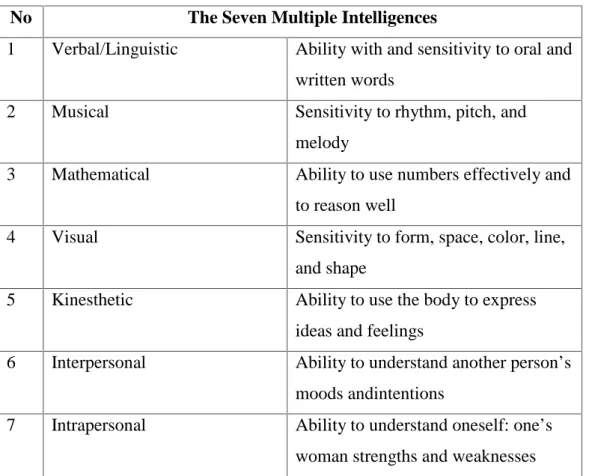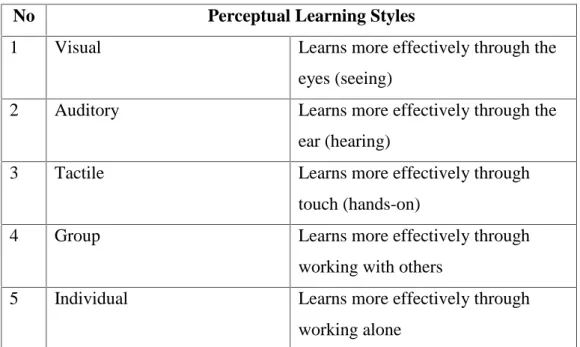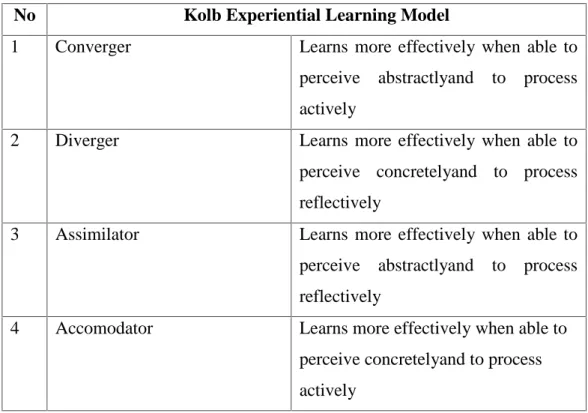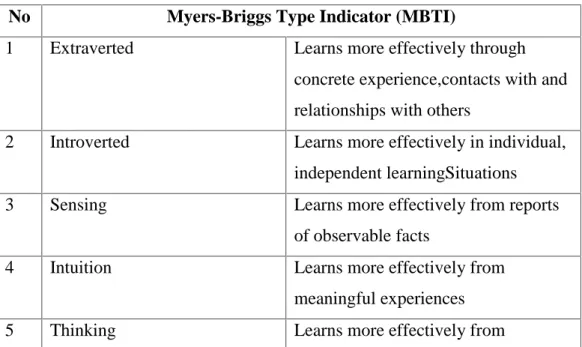Learning style of students in the first grade SMA Negeri 1 Bantaeng students (A descriptive study) in the academic year 2015/2016. The objective of this research was to find out the learning style preference of students in SMA Negeri 1 Bantaeng. The research applied descriptive study to see the learning style preference of students in SMA Negeri 1 Bantaeng.
The population of the research was the students of SMA Negeri 1 Bantaeng in the academic year 2015/2016. Data were analyzed descriptively using the Learning Styles Inventory and percentage scoring procedures. The research result showed that the students of SMA Negeri 1 Bantaeng have different learning style preferences, namely visual learning style (26.56%), auditory learning style (23.43%), tactile learning style (4.68%), visual and auditory learning style (32.81%), visual and tactile learning style (3.12%), visual, auditory and tactile learning style (9.37%). SMA Negeri 1 Bantaeng students prefer visual and auditory learning styles (32.81%).
Erwin Akib, S.Pd, M.Pd, Head of English Education Department of FKIP Makassar Muhammadiyah University. My heartfelt thanks to all the lecturers of FKIP UNISMUH especially the lecturers of the English Department and all the staff of Makassar Muhammadiyah University for their guidance during my years of study.
INTRODUCTION
- Problem Statements
- Objective of the Research
- Significance of the Research
- Scope of the Research
Based on the previous description, the researcher is interested in conducting a research entitled "Learning style of students in the first grade students of SMA Negeri 1 Bantaeng". This finding shows that students adapt their learning style preferences to the learning environment in which they are involved. It means that the researcher measures the learning style of the students that they choose in the learning process.
The data analysis shows that the learning style of the students in the first grades of SMA Negeri. It is signed in the data above; the highest percentage is in visual and auditory learning style (32.81%)'. Based on the result of data analysis and findings in the previous chapter, it can be concluded that the first grade students in SMA Negeri 1 Bantaeng sometimes prefer visual auditory learning style.
So the learning style preference of students in SMA Negeri 1 Bantaeng is visual, auditory learning style. 2013. The relationship between students' learning style and academic performance in Mara Vocational College, Malaysia. Malaysia: MARA Vocational Colleges.
REVIEW OF RELATED LITERATURE
Some Pertinent Ideas
The range and depth of learning styles vary because it seems impossible to limit a person's learning style to only a certain dimension, i.e. it cannot be said that a person is only visual, auditory or kinesthetic. For example, Korean students were found to be the most visual in their learning style preferences. A major assumption about how individuals learn, rather than the skills used in learning, underlies the learning style inventory.
Several researchers have tried to come up with ways in which learning style theory can be used in the classroom. While learning styles will inevitably differ between students in the classroom, Dunn and Dunn say teachers should try to make changes in their classrooms that are beneficial to each learning style. This framework assumed students' learning style focuses on three types of learning styles: visual, auditory, and tactile.
This research used the descriptive qualitative method to collect and describe the data and find out the learning style that has been applied by the students' learning style and the first semester students of SMA Negeri 1 Bantaeng. The first four categories make up the perceptual learning style categories and the other two make up the social category. They are tabulated to select which of these three language learning styles appeared most.
They have a tendency to have more than one learning style, so their characteristics are the combination of the single learning style. Otherwise, the person not only tends to be a single learning style learner, but also the combination of them that gives particular talent and lack. 1 Bantaeng prefer to learn English by exploring visual and auditory learning style because their teachers have visual and auditory teaching style.
Students who sometimes have a visual and auditory learning style have a greater ability to understand visual and audio materials than students who rarely use a visual and auditory learning style. We report and discuss the relationship between students' learning style preferences and the impact on English proficiency, which were statistically significant. Teachers must have knowledge of their students' learning style preferences because they play an important role in the learning process.
It is not fair for teachers to treat their students equally, as each student has a preference for learning style.

Conceptual Framework
RESEARCH METHOD
Research Variables
Population and Sample
It is a self-report questionnaire developed from existing learning style instruments, with some modifications suggested by non-native informants and American linguistics consultants. The questionnaire, designed and validated for non-native speakers, consists of five statements on each of the six learning style preferences to be measured: visual, auditory, kinesthetic, tactile, group learning and individual learning. Place the point value on the line next to the corresponding item number and add the points to obtain learning style preference scores under each heading.
From the table above, out of 64 (sixty-four) students, (a) 17 students have a visual learning style, out of which some are often visual, 7 of them are sometimes visual and 7 of them are rarely visual. (b) 15 students have a auditory learning style (23.43%); none of them are often auditory, 7 of them are sometimes auditory and 8 of them are rarely auditory (c) 3 students have tactile learning style (4.68%); none of them are often tangible, 1 of them is sometimes tangible, and 2 of them are rarely tangible, (d) 21 students have a visual and auditory learning style (32.81%); none of them are often visual and auditory, 7 of them are sometimes visual and auditory, 14 of them rarely get visual and auditory tired. (e) 2 students have a visual and tactile learning style (3.12%); none of them is often visual and tactile, 1 of them is sometimes visual and tactile, and 1 of them is rarely visual and tactile (f) 6 students have visual, auditory and tactile learning style (9.37%); 1 Bantaeng strongly favors visual and auditory learning styles. It can be interpreted that the first students of SMA are Negeri. 1 Bantaeng should use visual and audio equipment in their learning process and the teachers of SMA Negeri.
Tactile learners are learners who have certain characteristics, such as (a) hold a pen or pencil very hard when writing, (b) enjoy working with tools, (c) play with coins or keys in their pocket, (d) chew. chewing gum, smoke or snack while learning, (e) learning to spell by "fingerspelling" words, (f) are good at solving and working on puzzles and mazes, (g) grasping objects while learning, and (h) ) feel very comfortable touching others, hugging, shaking hands, etc. A visual and tactile learner can explain that their characteristics are a combination of visual and tactile characteristics. Visual and auditory styles are the most popular learning styles with a mean of 26.56 and 23.43 respectively.
For my teachers in SMA Negeri 1 Bantaeng, especially my English teacher, the results of this study can be taken as a reference, so they will not only learn by asking students to answer exercises in LKS, but also teach using a variety of methods that can accommodate learning styles. preferences of their students. And then, for the students of SMA Negeri 1 Bantaeng, they need to know their learning style early on, so that when they conduct their learning independently, they can use the learning strategy based on the style their learning. 2003, Synthesis of the Dunn and Dunn Learning Style Model: Who, What, When, Where, and So What?, Center for the Study of Learning and Teaching Styles, St John's University, New York, NY.


